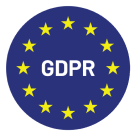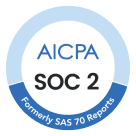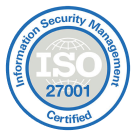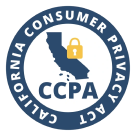The Remedy for Healthcare Call Center Challenges: 8 Proven Solutions
Healthcare miscommunication cost $1.7 billion and nearly 2,000 lives over five years*. Is your call center doing enough to avoid this?
Whether a patient is scheduling an appointment, seeking urgent medical advice, or following up on treatment, clear and efficient communication can literally mean the difference between life and death.
Yet, despite the high stakes, many healthcare call centers struggle to keep up with the demands of their role. Ensuring fast, accurate, and compassionate patient support is no small task, and numerous obstacles stand in the way.
To overcome these challenges, the solution is around the corner. From HIPAA-compliant tools to AI automation and real-time analytics, modern call center solutions can streamline operations, enhance patient experience, and improve care coordination.
In this article, we’ll explore eight healthcare call center best practices that help you optimize communication and ensure every patient receives the support they need.
Key Takeaways
- Communication failures account for 80%* of serious medical errors, leading to misdiagnoses, delays in care, and even preventable deaths.
- Healthcare call centers face long wait times, misrouted calls, compliance risks, and system gaps, making it difficult to deliver fast, efficient, and secure patient care.
- By choosing call center software with HIPAA compliance, AI automation, and seamless integrations, you can ensure your team overcomes these challenges, reducing errors and improving customer experience.
If your call center health is on the line, try CloudTalk free for 14 days.
The Challenges of Communication in Healthcare
Effective communication is at the heart of quality healthcare, yet call centers frequently encounter obstacles that disrupt efficiency and patient care.
When these breakdowns occur, the consequences go beyond frustration—they can lead to misdiagnoses, delayed treatments, compliance breaches, and even life-threatening situations.
Here are four major challenges healthcare call centers must overcome:
1. Long Call Wait Times
Nobody likes waiting on hold, especially when they’re unwell or worried about a loved one. Yet, in many healthcare call centers without an efficient phone system, long wait times are the norm, not the exception.
Patients often get bounced between departments, repeating the same information over and over. It’s frustrating for them and just as frustrating for the agents trying to manage high call volumes with limited resources.
2. High Stakes of Patient Data Security
Handling patient information is a huge responsibility, and healthcare call centers must follow strict HIPAA regulations to keep data secure. At the same time, agents need to provide fast, efficient service, which is a tough balance to maintain.
One mistake can have serious consequences—from hefty fines and legal trouble to lost patient trust and even compromised care. In healthcare, a data mishap isn’t just a technical issue—it’s a safety risk.
3. Lack of Integration Across Systems
Many healthcare call centers still rely on outdated tools, making it harder to share critical information quickly. Without proper integration with CRMs and modern communication systems, delays happen, impacting operational efficiency.
Missed appointments are one of the major consequences–37% of patients* skip appointments simply because they forgot. A modern contact center solution can fix this by automating reminders and post-op follow-ups, ensuring patients stay on track.
4. High Call Volumes and Burnout
The high-intense nature of healthcare call centers means that agents are frequently dealing with urgent or emotionally charged situations. The pressure to be fast, accurate, and compassionate all at once is intense, and it takes a toll.
A continuous influx of high call volume—especially during public health crises—can overwhelm staff. This may lead to burnout, high turnover rates, and a decline in service quality.
8 Best Practices to Improve Healthcare Call Center Communication
With the right tools and strategies, you can tackle healthcare call center challenges and keep communication seamless. Here are eight best practices to help streamline operations and deliver better patient support.
1. Use a HIPAA-Compliant Communication Tool
When it comes to patient data, there’s no choice but to follow the law. Healthcare call centers handle sensitive information daily, so using a HIPAA-compliant communication tool is non-negotiable.
That means encrypted calls, secure messaging, and strict access controls to keep patient details safe from unauthorized access or data breaches. A cloud-based, HIPAA-compliant call center system makes it easier to protect information while still giving agents the tools they need to assist patients efficiently.
Example:
A patient calls to ask about their lab results. Sharing sensitive data over a non-encrypted line risks a breach, but with a HIPAA-compliant call center solution, the agent securely verifies the patient’s identity and provides the results—ensuring compliance and protecting patient privacy.
A modern, secure solution for healthcare call centers against cybersecurity threats.
2. Reduce Patient Hold Times with Smart Call Routing
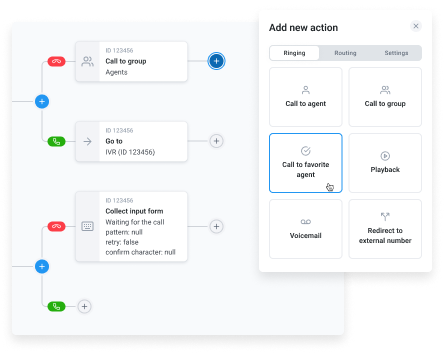
One of the biggest pain points in healthcare call centers is inefficient call transfers, which lead to frustration for both patients and agents. Implementing intelligent call routing ensures that patients reach the right department or specialist on the first attempt.
Features like Caller-based Routing and Interactive Voice Response (IVR) can help direct calls based on patient records and needs, reducing unnecessary transfers and improving resolution times.
Example:
A patient calls to schedule an urgent appointment, but instead of multiple transfers, an intelligent call routing system instantly accesses their medical history and directs them to the right department. Within minutes, their appointment is booked—quickly and hassle-free.
3. Train Agents for Empathy, Efficiency and Compliance
A healthcare call center’s success depends on both compassion and efficiency. Regular workshops on active listening and empathetic communication help agents handle patient concerns with patience and professionalism.
HIPAA training is equally crucial—agents must understand how to handle sensitive data securely to ensure compliance and protect patient privacy. By focusing on empathy, efficiency, and data security, healthcare call centers can create an excellent and supportive patient experience.
Example:
An elderly patient needs a prescription refill but has trouble understanding the process. The agent patiently explains the steps, using clear, reassuring language. Meanwhile, HIPAA training ensures proper identity verification before accessing medical records, keeping the interaction secure and compliant.
4. Leverage Omnichannel Communication
Patients expect convenient and accessible communication, whether through phone calls, chat, email, or SMS. An omnichannel approach ensures they can reach support through their preferred method without repeating information across channels.
By integrating all communication platforms into a single system, healthcare call centers create a smooth, unified customer experience. Agents can access patient history and past interactions instantly, allowing for faster resolutions and more personalized care.
Example:
A client forgets their appointment time but receives an automated email reminder with all the details. Instead of calling and waiting on hold, they reply via SMS to reschedule instantly. Within moments, they receive a confirmation—saving time and ensuring they stay on track with their care.
5. Utilize AI and Automation for Faster Resolutions

Artificial intelligence and automation are strong allies. AI-powered chatbots, for example, can handle routine inquiries like appointment scheduling, prescription refills, and basic FAQs, freeing up agents to focus on more complex issues.
By leveraging AI-powered features, healthcare providers can enhance efficiency. They reduce agent workload and deliver faster, more personalized patient care without compromising quality or compliance.
Example:
An agent follows up with a patient about their ongoing symptoms after a recent diagnosis. With AI-powered call transcription, they quickly review past conversations and updates in the CRM, ensuring they have accurate details. Later, doctors can review key information instantly for a faster, more informed follow-up.
6. Integrate The Systems in Your Toolstack
Disconnected systems are the starting point for delays, miscommunication, and errors. When there is no data connectivity, it is difficult to know the most recent and reliable source.
Seamless integration between call center software, Electronic Health Records (EHRs), and CRM platforms ensures that patient information is up-to-date and easily accessible. This enables agents to provide faster, more informed responses and avoid confusion.
Example:
A patient calls about persistent migraines, unsure if their treatment needs adjustment. Without CRM and EHR integration, the agent would have to search multiple systems or call back later. With seamless integration, they instantly access past prescriptions and treatment history, providing immediate guidance and scheduling a follow-up if needed, and doctor’s notes, providing a quick answer and scheduling a follow-up—ensuring efficient, hassle-free care.
7. Monitor Key Metrics for Continuous Improvement
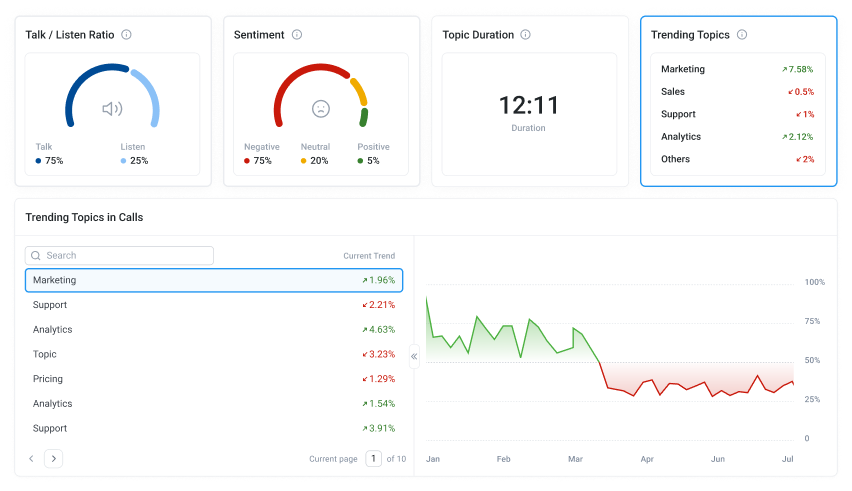
Tracking healthcare call center metrics such as call resolution times, patient satisfaction scores, and abandoned call rates gives valuable insight into where your call center excels—and where it needs work.
Call Recordings and Analytics help identify training gaps, refine workflows, and improve patient interactions. By regularly reviewing performance data, healthcare call center managers can spot inefficiencies and use Call Monitoring to coach agents, improving overall service quality.
Example:
A healthcare call center notices a rise in abandoned calls during peak hours. By reviewing call recordings and performance analytics, they identify frequent and time-consuming call transfers. With targeted healthcare call center training, they implement a new workflow to speed up first call resolution.
8. Provide 24/7 Support to Enhance Patient Care
Healthcare needs don’t follow a 9-to-5 schedule, and neither should patient support. Implementing after-hours support ensures that urgent medical inquiries are addressed promptly, even outside regular business hours.
A smart call queue system further improves efficiency by prioritizing urgent calls, offering callback options, and managing peak hours seamlessly. With automated scheduling and virtual hold features, healthcare providers can reduce abandoned calls and boost patient satisfaction.
Example:
A patient wakes up with severe side effects from a new medication but calls outside clinic hours. Instead of reaching voicemail, they are connected to an after-hours nurse line that prioritizes urgent cases. Thanks to a smart call queue and callback options, they receive guidance without having to wait until morning.
The Prescription To Heal Your Call Center: Cloudtalk
In healthcare, miscommunication doesn’t end with a simple misunderstanding. 80%* of serious medical errors stem from communication failures, leading to delays in care, misdiagnoses, and unnecessary complications.
When every call holds someone’s health on the line, you need a reliable, secure, and efficient communication system to keep operations running smoothly and patients well cared for.
The right solution can be the medicine your call center needs. CloudTalk is built for high-demand healthcare environments, offering HIPAA-compliant VoIP with AI-powered automation and seamless integrations to eliminate communication gaps.
A single dose of CloudTalk can save your call center’s health.
Sources:
FAQs
Should I outsource my healthcare call center services?
Outsourcing can reduce costs and improve efficiency, but maintaining in-house control ensures better compliance, security, and patient experience.
How does a call center for health insurance work?
Call centers for health insurance handle policy inquiries, claims processing, and provider coordination, ensuring seamless communication between patients, insurers, and healthcare providers.
Why is HIPAA compliance important for healthcare call centers?
HIPAA ensures patient data stays secure, preventing breaches, fines, and legal issues while maintaining trust and compliance with healthcare regulations.
What is the average handle time for a healthcare call center?
Healthcare call center benchmarks show that average handle time (AHT) typically ranges from 4 to 8 minutes, depending on call complexity, patient needs, and system efficiency.
What healthcare call center metrics should I be tracking?
Track key healthcare call center benchmarks like AHT, first-call resolution, patient satisfaction, abandoned call rates, and compliance adherence to optimize efficiency, reduce errors, and improve patient care.













